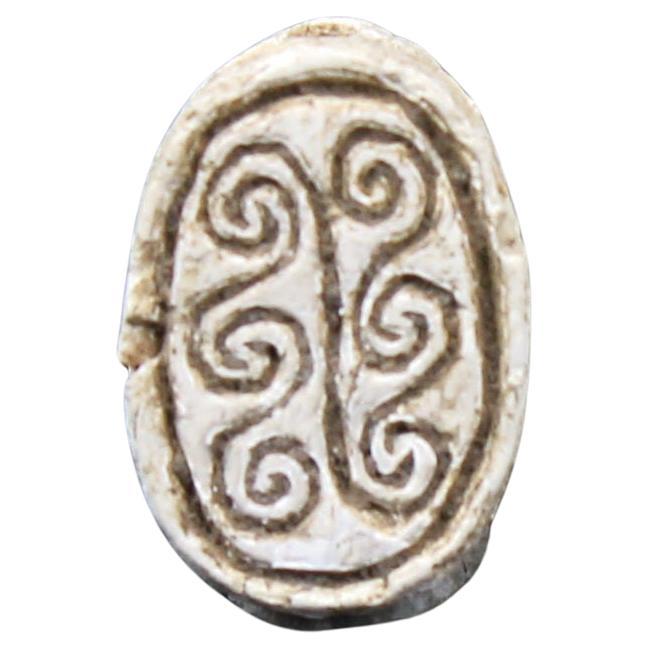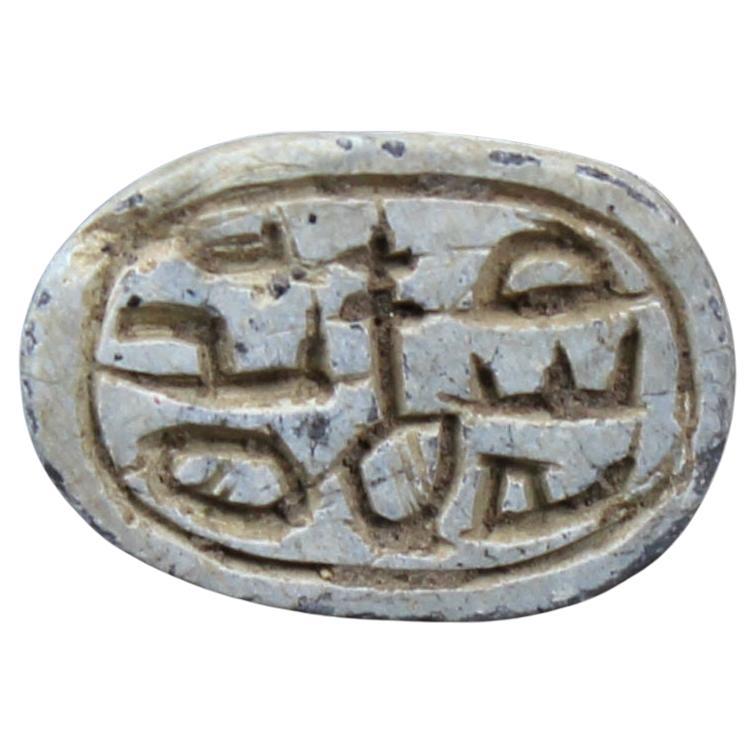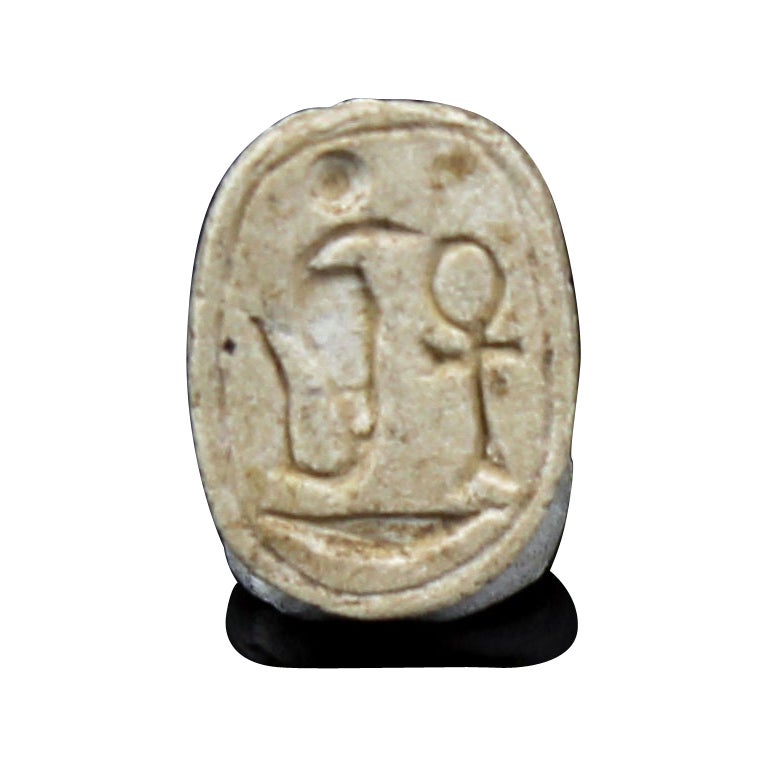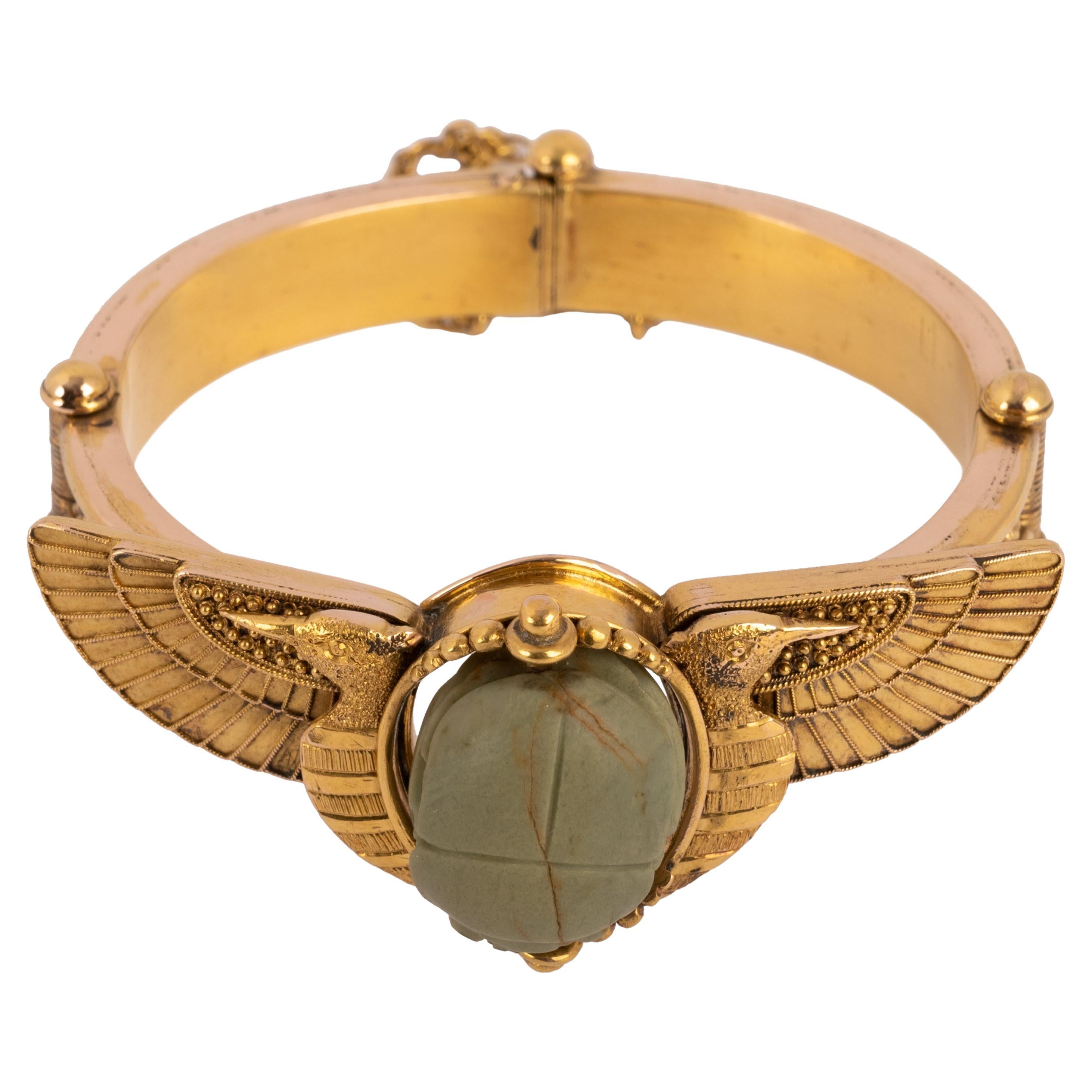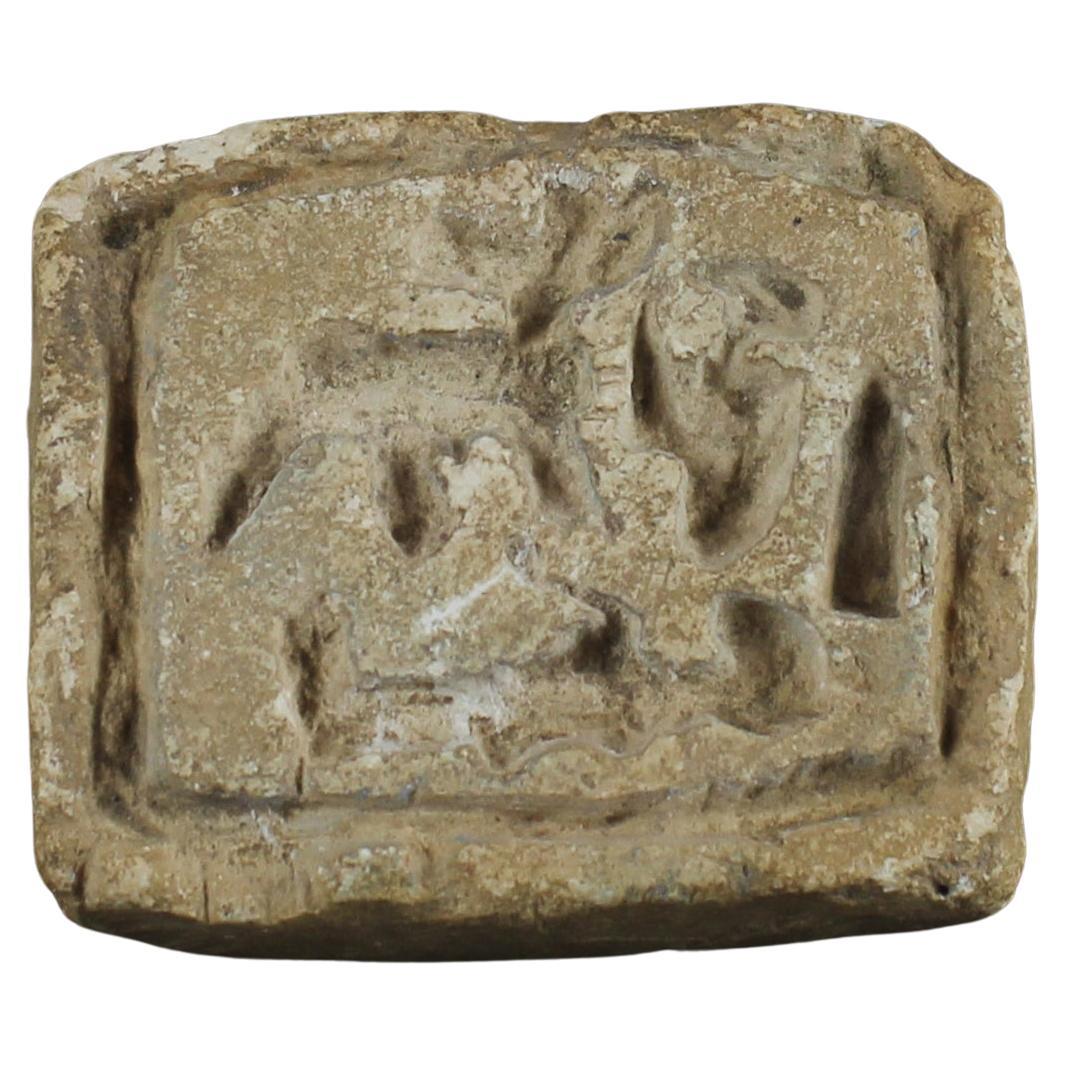Items Similar to Scarab with prenomen for Amenhotep II
Want more images or videos?
Request additional images or videos from the seller
1 of 6
Scarab with prenomen for Amenhotep II
About the Item
ITEM: Scarab with prenomen for Amenhotep II
MATERIAL: Steatite
CULTURE: Egyptian
PERIOD: New Kingdom, XVIIIth Dynasty, 1143 – 1417 B.C
DIMENSIONS: 15 mm x 11 mm
CONDITION: Good condition
PROVENANCE: Ex American egyptologist collection, active in the early part of the 20th century, brought to the US with the family in 1954.
Comes with Certificate of Authenticity and Export Licence. If you are from outside the European Union, we will have to apply for the export licence again for your country, this takes 4 to 6 weeks.
Amenhotep II, the seventh pharaoh of the 18th Dynasty of ancient Egypt, ruled during the New Kingdom period around the 15th century BCE. Renowned for his military prowess, Amenhotep II expanded the Egyptian empire through numerous campaigns, solidifying control over territories in Nubia and the Levant. His expeditions into Syria and Canaan, notably the Battle of Megiddo, showcased his strategic acumen as he secured victories against local rebellions and coalitions, leaving behind inscriptions and reliefs that celebrated his triumphs.
Beyond his military endeavors, Amenhotep II also left a mark through his architectural projects, albeit less pronounced compared to other pharaohs. He oversaw the construction of temples and monuments across Egypt, contributing to the cultural landscape of the time. Additionally, Amenhotep II was known for his personal interests in sports and physical activities, with depictions showcasing him engaging in hunting, chariot racing, and archery, reflecting the pursuits of Egyptian nobility and emphasizing the ideal of the warrior-king.
While Amenhotep II's reign brought stability and prosperity to Egypt, his legacy is overshadowed by some of his predecessors and successors. Despite his military successes and contributions to Egyptian architecture, he is not as widely celebrated as figures like Thutmose III or Ramses II.
- Dimensions:Height: 0.6 in (1.5 cm)Width: 0.44 in (1.1 cm)Depth: 0.01 in (0.1 mm)
- Style:Egyptian (Of the Period)
- Materials and Techniques:
- Place of Origin:
- Period:
- Date of Manufacture:New Kingdom, XVIIIth Dynasty, 1143 – 1417 B.C
- Condition:
- Seller Location:EL CAMPELLO, ES
- Reference Number:1stDibs: LU7382238735882
About the Seller
5.0
Vetted Seller
These experienced sellers undergo a comprehensive evaluation by our team of in-house experts.
Established in 2011
1stDibs seller since 2022
8 sales on 1stDibs
- ShippingRetrieving quote...Ships From: El Campello, Spain
- Return PolicyA return for this item may be initiated within 60 days of delivery.
More From This SellerView All
- Egyptian scarab as a commemorative of Ramesses II or prenomen of Shoshenq IIILocated in EL CAMPELLO, ESITEM: Scarab as a commemorative of Ramesses II or prenomen of Shoshenq III MATERIAL: Black steatite CULTURE: Egyptian PERIOD: New Kingdom to Third Intermediate Period, 1279 – 664 B.C...Category
Antique 15th Century and Earlier Egyptian Egyptian Antiquities
MaterialsStone
- Egyptian scarab with spiral designLocated in EL CAMPELLO, ESITEM: Scarab with spiral design MATERIAL: Steatite CULTURE: Egyptian PERIOD: Second Intermediate Period, 1700 – 1550 B.C DIMENSIONS: 12 mm x 9 mm CONDITION: Good condition PROVENANCE...Category
Antique 15th Century and Earlier Egyptian Egyptian Antiquities
MaterialsStone
- Egyptian scarab with pseudo-hieroglyphic, Anra-typeLocated in EL CAMPELLO, ESITEM: Scarab with pseudo-hieroglyphic, Anra-type MATERIAL: Steatite CULTURE: Egyptian PERIOD: Second Intermediate Period, 1700 – 1550 B.C DIMENSIONS: 10 mm x 15 mm CONDITION: Good co...Category
Antique 15th Century and Earlier Egyptian Egyptian Antiquities
MaterialsStone
- Egyptian scarab with Uraeus, Ankh and neb basket (Amun trigram)Located in EL CAMPELLO, ESITEM: Scarab with Uraeus, Ankh and neb basket (Amun trigram) MATERIAL: Steatite CULTURE: Egyptian PERIOD: New Kingdom, 1550 – 1070 B.C DIMENSIONS: 12 mm x 8 mm CONDITION: Good condit...Category
Antique 15th Century and Earlier Egyptian Egyptian Antiquities
MaterialsStone
- Egyptian seal with Ptah, Anubis and vultureLocated in EL CAMPELLO, ESITEM: Seal with Ptah, Anubis and vulture MATERIAL: Stone CULTURE: Egyptian PERIOD: Middle Kingdom, 2040 – 1782 B.C DIMENSIONS: 39 mm x 45 mm x 32 mm CONDITION: Good condition PROVENA...Category
Antique 15th Century and Earlier Egyptian Egyptian Antiquities
MaterialsStone
- Greek slingshot with (…)EM(…)Located in EL CAMPELLO, ESITEM: Slingshot with (…)EM(…) MATERIAL: Lead CULTURE: Greek PERIOD: 4th Century B.C DIMENSIONS: 15 mm x 29 mm CONDITION: Good condition PROVENANCE: Ex English private collection, acquired between 1980 – 1990 Comes with Certificate of Authenticity and Export license (If you live outside the European Union, We will have to apply for an export licence for your country and shipping will take 3 to 5 weeks.) Sling, implement for propelling missiles, one of the first missile weapons used in warfare. It consisted of a small strap or socket of leather to which two cords were attached. The warrior, or slinger, held the ends of the cords in one hand, placed the missile snugly in the strap, and whirled the socket and missile rapidly around his head; by letting go of one cord at the right moment, the slinger could let the missile fly out of the socket at a high speed. In the Roman army...Category
Antique 15th Century and Earlier Greek Classical Greek Antiquities
MaterialsLead
You May Also Like
- Antique 22 Karat Gold Egyptian Etruscan Revival Scarab Beetle Bracelet 1870Located in Portland, ORA rare antique Egyptian Revival 22 karat gold bracelet, circa 1870. Gold weight 38.10 grams. This continental gold bracelet tests as 22 karat gold and is fitted with a green faience ancient Egyptian scarab, engraved with Hieroglyphics. The front of the bracelet is modelled as a twin headed winged ibis amulet and is fitted to the center with a faience scarab, which swivels to show the Hieroglyphics. The bracelet band having Etruscan style beaded granulated decoration and a strong closing clasp and opening chain. Condition is excellent. The bracelet was last purchased in 1968 from the prestigious London antique jewelery dealers; Anne Bloom located at 124 New Bond Street London for 1500 (Great British Pounds...Category
Antique 1870s French Egyptian Revival Antiquities
MaterialsGold
- Egyptian Copper Plate with Silver Inlay Hieroglyphics, Early 19th CenturyLocated in Islamabad, PKThe large-scale copper charger plate with silver inlay is a truly awe-inspiring work of art. Its grand size and intricate design make it a captivating piece that commands attention a...Category
Antique 19th Century Egyptian Egyptian Antiquities
MaterialsSilver, Copper
- George II Pine MantelpieceLocated in Perth, GBFine George II Mantlepiece originally Housed in Edinburgh Good Crisp Carving , This has been painted in its history and is presently in its original carved state. This can be painted...Category
Antique Early 18th Century Scottish George II Antiquities
MaterialsWood
- Japanese Haori for Women with Silk: Sky Blue, 1950sLocated in Paris, FRThis is a silk jacket which was made in Japan. It was made in Showa era around 1950s. The main colour is sky blue but these flowers are in several colours. There is two haori himo to close this jacket. The haori is a traditional Japanese jacket...Category
Mid-20th Century Japanese Showa Antiquities
MaterialsSilk
- Japanese Haori Jacket for Women with Silk: Purple 1940sLocated in Paris, FRThis is a jacket for women called Haori in Japan. This was made around 1940s in Showa era. -Details- Design: butterflies Fabric: Silk Era: Show...Category
Vintage 1940s Japanese Antiquities
MaterialsSilk
- Set of Four Egyptian Antiquities, Pair of Sarcophagus Faience & Two FigurinesLocated in New York, NYThis captivating authentic Egyptian Faience set was realized in ancient Egypt circa 3100 BCE. It offers two sarcophagus figurines- suggestive of miniature versions of King Tut's tomb- hand finished in a beautiful turquoise hue (a glaze created by pulverizing the stone into pigment). Additionally, the set features two figurines (one representative of the Egyptian god Anubis), and the other seemingly a depiction of one of the ruler's as a young child also in a turquoise glaze atop volumetric rhombus plinths with tapered sides in a refined terra cotta hue. Full of historical importance (and stunning as stand alone objects) this collection of Egyptian antiquities...Category
Antique 15th Century and Earlier Egyptian Egyptian Figurative Sculptures
MaterialsFaience
Recently Viewed
View AllMore Ways To Browse
Long 36 60 Inches Wall Mirror
Asian Art Deco Furniture
Wood And Metal Lamp
Glasses Set Of 12
Mid Century Table With Crafted Top
Asian Asian Screen
Art Deco Office Items
People In Garden
Midcentury Swedish Carpet
Table With Ormolu
Glass Metal Wall Art
Leather Tooling
Vase Vessel Orange
Line Pendant
Wall Mount Mirror
Wood Case Chair
Mid Century Office Chairs Set
Wooden Chair With Upholstery

